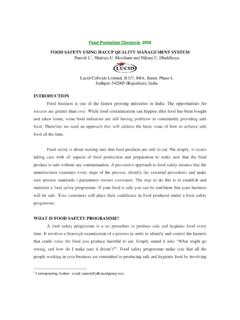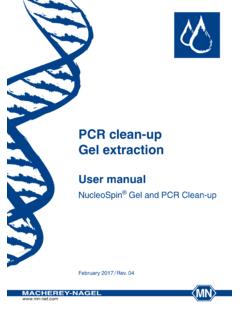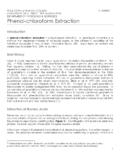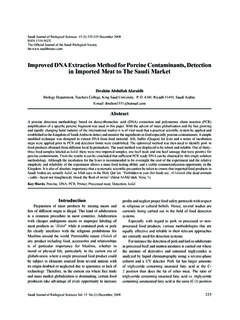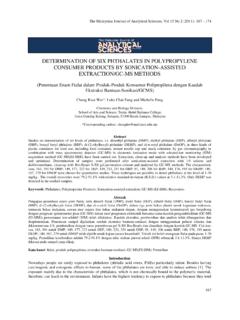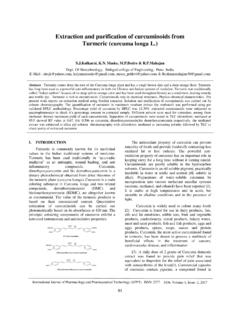Transcription of An Overview on Pectins Introduction Structure - …
1 Times Food Processing Journal, June-July Issue, Page no. 44-51 (2006) An Overview on Pectins Sharma, Naresh L., Dhuldhoya, Merchant and Merchant Lucid Colloids Limited Jodhpur-342005, Rajasthan, India Introduction Pectins have been utilised for their functionality in foods for many years. Ubiquitous in the conserves and preserves industries, development of Pectins has centred on its use to impart texture in high sugar systems. pectin has been widely studied and published but is difficult to characterise as a model system due to the heterogeneous nature of the polymer. Industrial use has mainly been focussed on tailoring the polymer to specific needs.
2 Structure Backbone Structure Pectins are a family of complex polysaccharides that contain 1,4-linked -D-galactosyluronic residues. Three pectic polysaccharides, homogalacturonan, rhamnogalacturonan-I and substituted galacturonans, have been isolated from primary plant cell walls. Homogalacturonan (HG) is a linear chain of 1,4-linked -D-galactosyluronic residues, in which some of the carboxyl groups are methyl esterified. They may also be O-acetylated at the C-2 and C-3 positions. Homogalacturonans have been isolated from sunflower heads and apple pectin but were obtained by extraction treatments likely to cleave covalent bonds so they may have been released from a heterogeneous pectic polysaccharide.
3 pectin is not a homopolysaccharide however and has rhamnopyranosyl residues inserted in the galactosyluronic backbone at 1 to 4% substitution. The other major feature of these rhamnogalacturonan-I (RG-I) chains are large substituted side chains. Between 20 and 80% of the rhamnopyranosyl residues are, depending on plant source and method of isolation, substituted at C-4 with neutral and acidic oligosaccharide side chains. The predominant side chains contain large linear and branched -L-arabinofuranosyl and/or -D-galactopyranosyl residues and their relative proportion and chain lengths may differ depending on plant source.
4 Other rarer side chains are also present and generally shorter. The final and much more minor component of the backbone is rhamnogalacturonan-II (RG-II). This is not structurally related to RG-I since its backbone is composed of 1,4-linked -D-galactosyluronic residues like HG. At approximately 30 glycosyl residues long it has a non-saccharide and an octasaccharide side chain attached to C-2 of some of the backbone residues and two structurally different disaccharides attached to C-3 of the backbone. RG-II is of interest as it occurs in relatively high amounts in wine and other fruit juices and it has been demonstrated that it binds heavy metals and has immunomodulating activities.
5 It is possible to separate essentially pure galacturonan fractions from other high molecular weight pectin fractions by degrading purified Pectins specifically in the galacturonan backbone either chemically or enzymatically . It appears that there is an intramolecular distribution in which the neutral sugars are concentrated in blocks of more highly substituted rhamnogalacturonan regions ('hairy' regions) which are separated in the polymer by D-galactosyluronic-rich regions ('smooth' regions). These smooth regions can be up to 100 units in length. Functional Groups Pectins also carry nonsugar subsituents, essentially methanol, acetic acid, phenolic acids and occasionally amide groups.
6 The esterification of galacturonic acid residues with methanol or acetic acid is a very important structural characteristic of pectic substances. The degree of methylation (DM) is defined as the percentage of carbonyl groups esterified with methanol. If more than 50% of the carboxyl groups are methylated the Pectins are called high-methoxy Pectins (HM), and less than that degree of methylation are called low methoxy (LM) Pectins . This same principal applies to acetylation although the degree of acetylation (DAc) can be larger than 100% as galacturonosyl residues can be acetylated with more than one group per monosaccharide.
7 Acetyl groups are generally present in the 'hairy' rhamnogalacturonan regions and only present in very low amount in homogalacturonan from apple and citrus. They can be present in much higher amounts in homogalacturonan from sugarbeet and potato. Methyl esterification is common in native Pectins but acetylation is rarer in natural extracts. Overall the degree of substitution is known as the degree of esterification (DE). For native apple Pectins a random distribution of the metheyl esters groups over the galacturonan backbone was found. For commercially extracted Pectins with tailored DM the distribution depends on the raw material and the extraction and de-esterification conditions.
8 The overall polysaccharide is therefore ionic but with large neutral regions giving interesting functionalities. Commercial Pectins can also be amidated. The amidation improves the gelling ability of low methoxy Pectins in that they need less calcium to gel and are less prone to precipitate at high calcium levels. Table 1: Composition of a number of pectin sources Component Sugarbeet pulp(% w/w) Apple pomace(% w/w) Citrus peels (% w/w) Pea hulls(% w/w) Rhamnose and Fucose Arabinose 8 Xylose Mannose 1 Galactose
9 5 Glc Galacturonic acid 26 Methanol - Ethanol 2 - 1 Proteins 8 - Lignin - - - Ash
10 2 - Gelation of Pectins Low methoxy pectin (LM) LM Pectins can gel in the presence of divalent cations, usually calcium. In these systems gelation is due to the formation of intermolecular junction zones between homogalacturonic smooth regions of different chains. The Structure of such a junction zone is generally ascribed to the so called 'egg box' binding process. Initial strong association of two polymers into a dimer is followed by the formation of weak interdimer aggregation, mainly governed by electrostatic interations.
